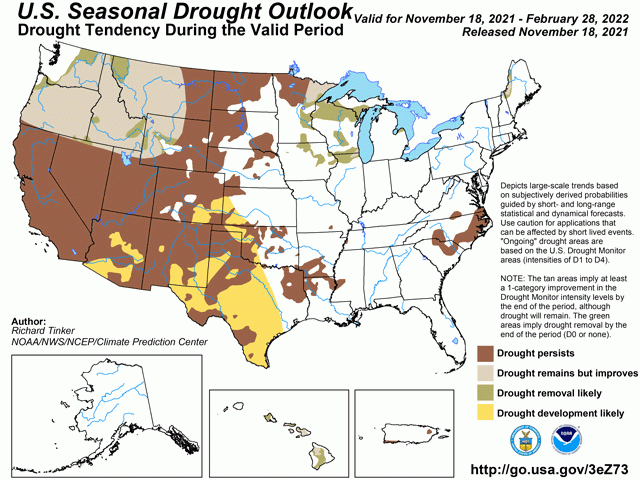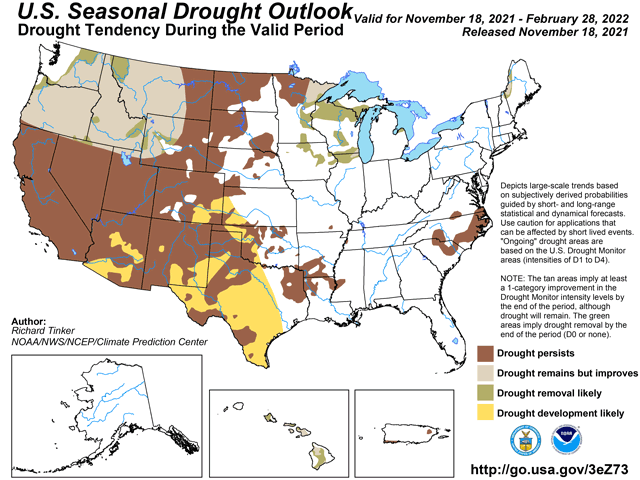Ag Weather Forum
La Nina Drives Variable Central US Drought Outlook
Widely mixed October precipitation in the north-central United States leaves some areas drought-free while other areas are still dry ahead of the winter season. That's the takeaway from monthly and seasonal forecast updates issued during mid-November.
Heavy precipitation, including some record rainfall in October, did make a positive impact on soil moisture levels in portions of the northeastern Plains, upper Midwest and the northern Rockies, according to Nebraska State Climatologist Martha Shulski. "There were two main areas of (drought) improvement -- portions of Wyoming and Montana along with the Great Lakes and part of Minnesota, Wisconsin, northern Illinois and northeast Iowa," Shulski said in a forecast conference call.
Shulski also noted that areas with heavy precipitation in October still did not show a big increase in river and stream flow, due to warm weather offering favorable conditions for moisture to soak into the ground. "What seems to be the case is that the precipitation is helping to fill the soil profile rather than changing the river flows," Shulski said.
However, sectors of the western Great Plains that were bypassed by the October precipitation are already showing stress. Shulski cited Montana, South Dakota and Colorado with around 25% of the winter wheat rated in poor to very poor condition. Also, the early snowpack in the Upper Missouri River Basin is running low, starting the runoff season from 30 to more than 50% below average.
P[L1] D[0x0] M[300x250] OOP[F] ADUNIT[] T[]
The outlook for winter 2021-22 precipitation in the central U.S. continues that wide variability. Much of that is driven by the presence of a La Nina cool sea surface temperature and barometric pressure combination in the Pacific Ocean, which is expected to be a primary large-scale weather maker through the entire winter season.
"La Nina conditions should peak in early winter before weakening later in winter and through the spring," said Nathan Hamblin, DTN long-range forecaster.
Pacific Ocean conditions show that La Nina is in effect for the second consecutive winter season, noted NOAA Climate Prediction Center forecaster Johnna Infanti. "Equatorial Pacific sea surface temperature anomalies are
negative from west of the date line to the South American coast with anomalies ranging from -0.7 to -1.0 degrees C (Celsius)," Infanti wrote in a forecast update. Pacific equator-region temperatures are expected to remain from 1.5 to 2.0 degrees C (2.7 to 3.6 degrees Fahrenheit) below normal through the entire meteorological winter season of December, January and February.
The presence of La Nina brings on some large differences in precipitation forecasts. For the central U.S., the western portion of the northern Plains along with the Great Lakes-Ohio Valley areas are in line for above-normal precipitation. In fact, the eastern Midwest could actually be too wet by the time spring 2022 begins; already, winter wheat in Michigan is around 25% in poor to very poor condition due to growth and development hindered by excessive moisture.
In contrast, the central portion of the Northern Plains through the southwestern Plains have drought expected to either continue or develop. This includes western Kansas, southeastern Colorado, western Oklahoma, and the western and southern two-thirds of Texas. If the forecast verifies, current favorable conditions for Kansas and Oklahoma wheat would see a decline by the end of the winter season. In Texas, wheat is already more than 35% rated poor to very poor; a dry winter would likely stress crop conditions even more.
Wildfire concern in drier areas will also be high without moisture. The past week already featured a big fire in western Nebraska. "Wildfire conditions are definitely a concern until we get snow cover in the western areas," Shulski said.
Bryce Anderson can be reached at Bryce.anderson@dtn.com
Follow him on Twitter @BAndersonDTN
(c) Copyright 2021 DTN, LLC. All rights reserved.






Comments
To comment, please Log In or Join our Community .